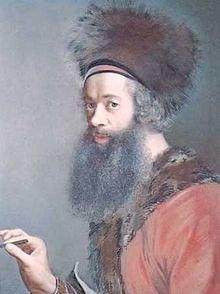Jean-Étienne Liotard
Jean-Étienne Liotard (French pronunciation: [ʒɑ̃n‿etjɛn ljɔtaʁ]; 22 December 1702 – 12 June 1789) was a Swiss[1] painter, art connoisseur and dealer. He is best known for his portraits in pastel, and for the works from his stay in Turkey. A Huguenot of French origin and citizen of the Republic of Geneva,[2] he was born and died in Geneva, but spent most of his career in stays in the capitals of Europe, where his portraits were much in demand. He worked in Rome, Istanbul, Paris, Vienna, London and other cities.
Life
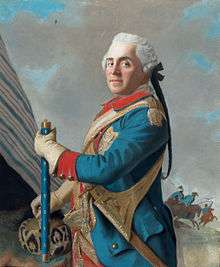
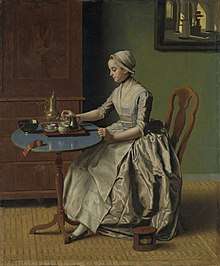
Liotard was born in Geneva. His father was a French Protestant jeweller who fled to Geneva after 1685. Jean-Étienne Liotard began his studies under Professors Daniel Gardelle and Petitot, whose enamels and miniatures he copied with considerable skill.
He went to Paris in 1725, studying under Jean-Baptiste Massé and François Lemoyne, on whose recommendation he was taken to Naples by the vicomte de Puysieux, Louis Philogène Brulart, Marquis de Puysieulx and Comte de Sillery. In 1735 he was in Rome, painting the portraits of Pope Clement XII and several cardinals. In 1738 he accompanied Lord Duncannon to Constantinople, where he worked for the next four years.[3]
Jean-Étienne Liotard visited Istanbul and painted numerous pastels of Turkish domestic scenes; he also continued to wear Turkish dress for much of the time when back in Europe. Using modern dress was considered unheroic and inelegant in history painting using Middle Eastern settings, with Europeans wearing local costume, as travellers were advised to do.
Many travellers had themselves painted in exotic Eastern dress on their return, including Lord Byron, as did many who had never left Europe, including Madame de Pompadour.[4] Byron's poetry was highly influential in introducing Europe to the heady cocktail of Romanticism in exotic Oriental settings which was later to dominate 19th century Oriental art.
His eccentric adoption of oriental costume secured him the nickname of the Turkish painter.[3]
He went to Vienna in 1742 to paint the portraits of the Imperial family. In 1745 he sold La belle chocolatière to Francesco Algarotti.
Still under distinguished patronage he returned to Paris. In 1753 he visited England, where he painted Princess Augusta of Saxe-Gotha, the Princess of Wales. He went to Holland in 1756, where, in the following year, he married Marie Fargues. She also came from a Hugenot family, and wanted him to shave off his beard.
In 1762 he painted portraits in Vienna, including Marie Antoinette; in 1770 in Paris. Another visit to England followed in 1772, and in the next two years his name figures among the Royal Academy exhibitors. He returned to his native town in 1776. In 1781 Liotard published his Traité des principes et des règles de la peinture. In his last days he painted still lifes and landscapes. He died at Geneva in 1789.
Works
Liotard was an artist of great versatility. Best known for his graceful and delicate pastel drawings,[5] of which La Liseuse, The Chocolate Girl, and La Belle Lyonnaise at the Dresden Gallery and Maria Frederike van Reede-Athlone at Seven at the J. Paul Getty Museum are delightful examples, he also achieved distinction for his enamels, copperplate engravings, and glass painting. Additionally, he wrote a Treatise on the Art of Painting and was an expert collector of paintings by the old masters.
Many of the masterpieces he had acquired were sold by him at high prices on his second visit to England. The museums of Amsterdam, Bern, and Geneva are particularly rich in examples of his paintings and pastel drawings. A picture of a Turk seated is at the Victoria and Albert Museum, while the British Museum owns two of his drawings.
The Louvre has, besides twenty-two drawings, a portrait of Lieutenant General Hérault as well as an oil painting of an English merchant and a friend dressed in costumes and entitled Monsieur Levett and Mademoiselle Helene Glavany in Turkish Costumes. A portrait of the artist is to be found at the Sala di pittori, in the Uffizi Gallery, Florence. As his son also married a Dutch girl, the Rijksmuseum inherited an important collection of his drawings and paintings.
One outstanding feature of Liotard's paintings is the prevalence of smiling subjects. Generally, portrait subjects of the time adopted a more serious tone. This levity was a reflection of the Enlightenment-era philosophies that inspired Liotard.[5] Also indicative of the era, Liotard created works celebrating science, like the painting of woman paying homage to the doctor that saved her. [5]
- Selected works
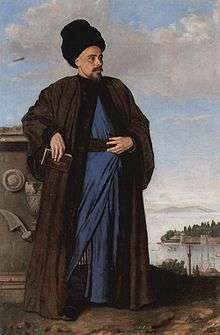 Richard Pococke, 1738–39, oil on canvas
Richard Pococke, 1738–39, oil on canvas.jpg) Portrait of a Turkish grand vizier, probably Hekimoğlu Ali Pasha, ca. 1738–1743, pastel on paper
Portrait of a Turkish grand vizier, probably Hekimoğlu Ali Pasha, ca. 1738–1743, pastel on paper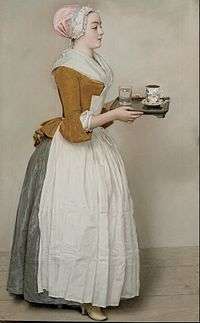 The Chocolate Girl 1743-1744
The Chocolate Girl 1743-1744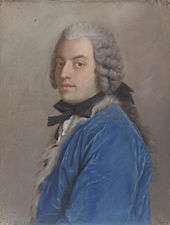 Count Francesco Algarotti,, 1745, pastel on parchment
Count Francesco Algarotti,, 1745, pastel on parchment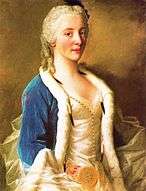 Marie Charlotte Boissier, 1746
Marie Charlotte Boissier, 1746 Jeanne-Elisabeth de Sellon, ca. 1746, pastel on parchment
Jeanne-Elisabeth de Sellon, ca. 1746, pastel on parchment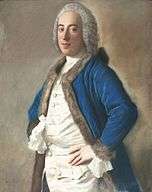 Portrait of Monsieur Boère, merchant from Genoa, 1746, pastel on parchment
Portrait of Monsieur Boère, merchant from Genoa, 1746, pastel on parchment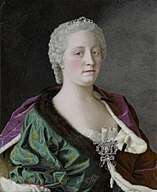 Empress Maria Theresia, 1747, enamel on copper
Empress Maria Theresia, 1747, enamel on copper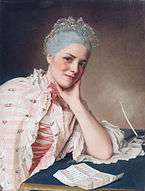 Portrait of Mademoiselle Jacquet, ca. 1748–1752, pastel on paper
Portrait of Mademoiselle Jacquet, ca. 1748–1752, pastel on paper Marie Josèphe von Sachsen, 1749, pastel on vellum
Marie Josèphe von Sachsen, 1749, pastel on vellum Self-portrait, ca 1749, pastel
Self-portrait, ca 1749, pastel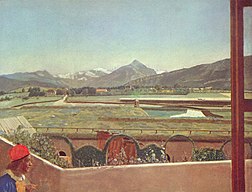 Landschaft bei Genf, 1750
Landschaft bei Genf, 1750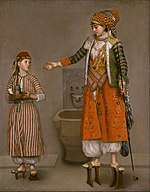 A Turkish Lady and her Servant, 1750, oil on canvas
A Turkish Lady and her Servant, 1750, oil on canvas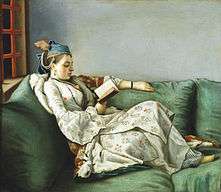 Marie Adelaide of France in Turkish dress, 1753, oil on canvas
Marie Adelaide of France in Turkish dress, 1753, oil on canvas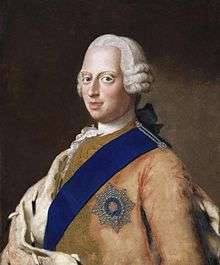 Portrait of Frederick, Prince of Wales, 1754, pastel on vellum
Portrait of Frederick, Prince of Wales, 1754, pastel on vellum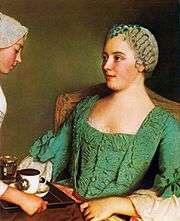 The first Cup, 1754, pastel on vellum
The first Cup, 1754, pastel on vellum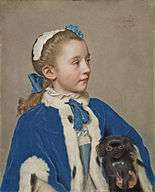 Maria Frederike van Reede-Athlone, 1755–56, pastel on vellum
Maria Frederike van Reede-Athlone, 1755–56, pastel on vellum Portrait of dr fr:François Tronchin, 1757, pastel on parchment
Portrait of dr fr:François Tronchin, 1757, pastel on parchment- Ami-Jean de la Rive, ca. 1758, pastel on paper
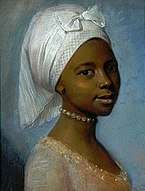 Portrait of a Young Woman, pastel
Portrait of a Young Woman, pastel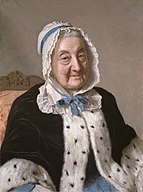 Portrait of Marthe Marie Tronchin, c. 1758 (Art Institute Chicago)
Portrait of Marthe Marie Tronchin, c. 1758 (Art Institute Chicago)%2C_Jean-%C3%89tienne_Liotard%2C_1758%2C_pastel_on_vellum%2C_63.6_by_50.6_cm%2C_Louvre%2C_Paris.jpg) Portrait of Madame Jean Tronchin (née Anne Molènes), 1758
Portrait of Madame Jean Tronchin (née Anne Molènes), 1758%2C_Jean-%C3%89tienne_Liotard%2C_1758%2C_pastel_on_vellum%2C_68_by_55_cm%2C_Mus%C3%A9e_d%E2%80%99art_et_d%E2%80%99histoire%2C_Geneva.jpg) Portrait of Madame François Tronchin (née Anne-Marie Fromaget), 1758
Portrait of Madame François Tronchin (née Anne-Marie Fromaget), 1758 Le petit déjeuner de la famille Lavergne, 1754
Le petit déjeuner de la famille Lavergne, 1754 Henry Frederick, Duke of Cumberland, 1754
Henry Frederick, Duke of Cumberland, 1754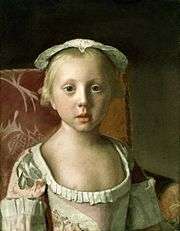 Portrait of Princess Louisa of Great Britain, 1754
Portrait of Princess Louisa of Great Britain, 1754- Marianne Liotard Holding a Doll, 1765
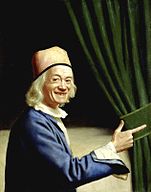 (circa 1770)
(circa 1770)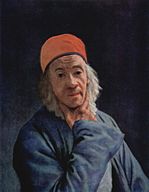 1773
1773 Still Life, Tea Set, ca. 1781–83, oil on canvas
Still Life, Tea Set, ca. 1781–83, oil on canvas Still life with Figs, 1782, pastel
Still life with Figs, 1782, pastel
| Wikimedia Commons has media related to Jean-Étienne Liotard. |
See also
References
- ULAN
- La Vendée La Terreur « Enquête sur l’histoire », trimestrial publication, Winter 93, number 5, p.74.
- Baetjer, Katharine, and Marjorie Shelley. 2011. Pastel Portraits: Images of 18th-century Europe. New Haven, Conn: Yale University Press. p. 12. ISBN 9780300169812.
- Christine Riding, Travellers and Sitters: The Orientalist Portrait, in Tromans, 48-75
- Jonathan Jones, Jean-Etienne Liotard review – a joyous time machine back to the Enlightenment, The Guardian, 20 October 2015.

External links
- Short biography
- 74 works by Liotard at the Musées d'Art et d'Histoire, Geneva
- Some paintings of Liotard in the Amsterdam Rijksmuseum
- Liotard on a Danish website
- Liotard in the Metropolitan Museum of Art
- Neil Jeffares, Dictionary of pastellists before 1800, online edition
- Liotard paintings at The J. Paul Getty Museum
